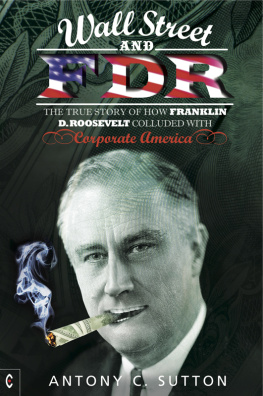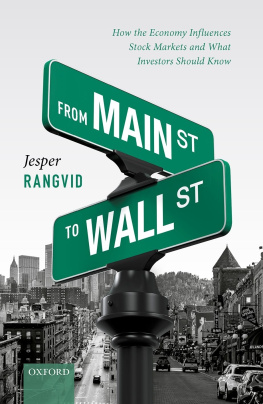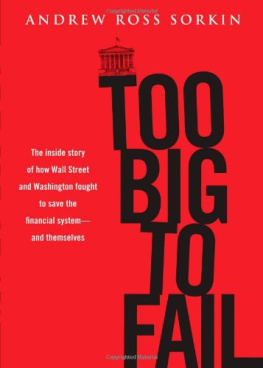TO JOSEPH, CONOR, JAMES, AND CHELE
(in order of appearance)

65 Bleecker Street
New York, NY 10012
Copyright 2015 by Richard E. Farley
All rights reserved, including the right to reproduce this book or portions thereof in any form whatsoever. For information address Regan Arts Subsidiary Rights Department, 65 Bleecker Street, New York, NY 10012.
Photo credits, which constitute an extension of this copyright page, appear .
First Regan Arts hardcover edition, May 2015.
Library of Congress Control Number: 2014955525
ISBN 978-1-941393-00-0
eISBN 978-1-941393-84-0 (eBook)
Interior design by Kris Tobiassen of Matchbook Digital
Jacket design by Richard Ljoenes
Jacket art by Bettmann/CORBIS (top); The National Archives/Franklin D. Roosevelt Library (left); Corbis (middle left); Bettmann/CORBIS (middle right); The Library of Congress (right)
The past is never dead. It isnt even past.
William Faulkner
TABLE OF CONTENTS
CAST OF CHARACTERS
(Positions Held at Times Relevant Herein)
I N THE E XECUTIVE B RANCH
At the White House:
Franklin D. Roosevelt, 32nd President of the United States
Eleanor Roosevelt, First Lady
Raymond Moley, Roosevelt adviser, member of the brain trust; nominally, an Assistant Secretary of State
Louis McHenry Howe, Roosevelts Chief of Staff
At the Treasury Department:
William H. Woodin, Secretary of the Treasury (1933)
Henry J. Morgenthau Jr., Secretary of the Treasury (19341945)
F. Gloyd Awalt, Acting Comptroller of the Currency
J.F.T. OConnor, Comptroller of the Currency
Dean G. Acheson, Undersecretary of the Treasury
Tom K. Smith, Special Assistant to Treasury Secretary Woodin
At the Federal Trade Commission:
James M. Landis, Commissioner (previously, Harvard Law School professor; and later, Commissioner, Securities and Exchange Commission)
Huston Thompson, Former Commissioner; Special Adviser
At the Commerce Department:
Daniel C. Roper, Secretary of Commerce
John Dickinson, Assistant Secretary of Commerce (former partner, Sullivan & Cromwell)
At the Reconstruction Finance Corporation:
Jesse Jones, President
Thomas Tommy the Cork Corcoran, Assistant General Counsel
At the Post Office Department:
James A. Farley, Postmaster General; also Chairman of the Democratic National Committee
At the Securities and Exchange Commission:
Joseph P. Kennedy, Chairman
George C. Mathews, Commissioner
Robert E. Healy, Commissioner
John J. Burns, General Counsel and Director of the Legal Division
David Saperstein, Director of the Trading and Exchange Division
Baldwin Bane, Executive Administrator; later, Director of the Registration Division
Donald Montgomery, Director of the Registration Division
James A. Fayne, Director of the Regional Administration Division
William O. Douglas, Director of the Protective Committee Study
Abe Fortas, Assistant Director of the Protective Committee Study
Edward Moore, Personal Assistant to the Chairman
I N C ONGRESS
At the United States Senate:
Carter Glass, Senator from Virginia
Huey P. Long, Senator from Louisiana
Duncan U. Fletcher, Senator from Florida; Chairman, Banking and Currency Committee
Joseph T. Robinson, Senator from Arkansas; Senate Majority Leader
Key Pittman, Senator from Nevada; Chairman, Foreign Relations Committee
Hiram W. Johnson, Senator from California
Arthur H. Vandenberg, Senator from Michigan
Ferdinand Pecora, Chief Counsel, Subcommittee on Stock Exchange Practices, Banking and Currency Committee; later, Commissioner, Securities and Exchange Commission
At the House of Representatives:
Samuel Sam T. Rayburn, Representative from Texas; Chairman, Interstate and Foreign Commerce Committee
Henry B. Steagall, Representative from Alabama; Chairman, Banking and Currency Committee
Henry T. Rainey, Representative from Illinois; Speaker of the House of Representatives
Fred Bitten, Representative from Illinois
Middleton G. Beaman, Legislative Counsel
O N W ALL S TREET
At the New York Stock Exchange:
Richard Whitney, President; Chairman, Richard Whitney & Co.
Edward A. Pierce, Member; Leader of the customers men broker faction; Chairman, E.A. Pierce & Co.
Charles R. Gay, President (succeeding Richard Whitney)
Frank Altschul, Chairman, Listing Committee; Partner, Lazard Frres & Company
Paul V. Shields, Member; Chairman, Shields & Co.; Leading Democrat among NYSE Members
At J.P. Morgan & Co.:
J.P. Morgan Jr., Managing Partner
George Whitney Jr., Partner
Russell C. Leffingwell, Partner
Thomas W. Lamont, Partner
S. Parker Gilbert, Partner
At National City Bank:
Charles E. Mitchell, Chairman
Gordon Rentschler, President
Hugh Baker, President of National City Company, National City Banks Securities Affiliate
At Chase National Bank:
Albert H. Wiggin, Former Chairman
At Kuhn, Loeb & Company:
Otto H. Kahn, Senior Partner
Elisha Walker, Partner
George W. Bovenizer, Partner
At Dillon, Read & Co.:
Clarence Dillon (Born Clarence Lapowski), Chairman
At M.J. Meehan & Co.:
Michael J. Meehan, Chairman
At W.E. Hutton & Company:
Bernard E. Sell Em Ben Smith, Partner
At Sullivan & Cromwell:
Arthur H. Dean, Partner
John Foster Dulles, Partner
Eustace Seligman, Partner
At Davis Polk & Wardwell:
John W. Davis, Partner
At Cravath, DeGersdorff, Swaine & Wood:
Alexander Henderson, Partner
At Carter Ledyard & Milburn:
Roland L. Redmond, Partner
At the Investment Bankers Association:
Frank M. Gordon, President
I N THE P RESS
William Randolph Hearst, Publisher, Hearst Newspapers
Arthur B. Krock, The New York Times, Washington Correspondent and Bureau Chief
John T. Flynn, writer; contributor to The New Republic and Harpers Magazine; investigator for Ferdinand Pecora
R EFORMERS IN THE P RIVATE S ECTOR
Felix Frankfurter, Professor, Harvard Law School
Benjamin V. Cohen, attorney, private practice
Samuel Untermyer, attorney, private practice
Edward A. Filene, department store magnate; philanthropist; founder, Twentieth Century Fund
PROLOGUE
BROTHER, CAN YOU SPARE A DIME?
In March 1933, the United States economy was in a shambles. The nationwide unemployment rate stood at 25 percent. In certain areas of the country, the rate was twice thatthis in an era when single income households were the norm. The nations financial system, the lifeblood of the economy, had ceased functioning, and banks were failing at an astounding rate.
In New York City, things were so desperate that Parks Commissioner Robert Moses ordered the sheep removed from the Central Park Zoo and relocated to Prospect Park in Brooklyn, where they could be securely protected from hungry residents of a nearby Hooverville who had taken to stealing the sheep and cooking them on open trash can fires.
famously captured the candidates unbridled optimism and self-confidence. Few of his fellow citizens found his optimism contagious.
That winter, Bing Crosby had a number-one hit song with Brother, Can You Spare a Dime? capturing the mood of disillusionment and despair that enveloped the nation between Roosevelts election and inauguration:
Next page






